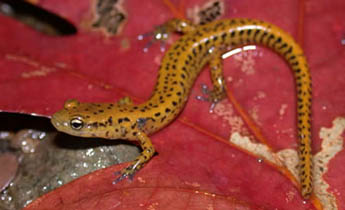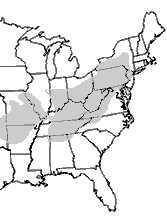Long-tailed Salamander (Eurycea longicauda)



Photos by J.D. Willson unless otherwise noted
| Description: The long-tailed salamander (Eurycea longicauda) is one of the largest species in the genus Eurycea. The size of this salamander ranges from about 4 to 8 inches (10-20 cm) long. As its name suggests, it has a noticeably long tail which forms 60-65% of the total body length in adults. The dorsum of the long-tailed salamander can vary from yellow, yellowish-orange, yellowish-brown, or even orange-red. The body has many black spots which can form broken lines. The tail has more distinct black spots, which often form vertical markings that can be in the shape of a dumbbell or herringbone. The venter is light yellow to off-white and may either be spotless or speckled with gray or light brown spots. Males which are sexually active have prominent cirri. Females also have cirri, but they are not nearly as evident as they are in the males. This species of salamander typically has 13-14 costal grooves.
Range and Habitat: In our region, Long-tailed salamanders are only found in northern Georgia. They are replaced by the closely-related Three-Lined Salamander (E. guttolineata) further south and east. Like most other species of plethodontid salamanders, Long-Tailed Salamanders prefer to hide underneath rotting logs, litter, and rocks during the day. Individuals are also frequently found under surface cover near the edge of springs, streams, and shaded seepages. Rock crevices and the entrances of caves and mine shafts also provide suitable habitat. Habits: Long-tailed salamanders are most active a few hours after sunset on humid or rainy nights to feed on several different types of invertebrates. They breed mostly in autumn and early winter. Larvae inhabit streams until they metamorphose. Adults can be found in large aggregates, which suggest that they are not territorial. For example, 80 individuals were found under a single slab of limestone in Ohio, and 300 individuals were collected in a single day at the end of a mine shaft. Conservation Status: Long-tailed salamanders are widely distributed and common. This species is not protected by federal law or Georgia state law. Pertinent References: Ireland, P.H. 1975. Eurycea longicauda. Cat. Amer. Amphib. Rept.: 221-1-221. Account Author: Benjamin Morrison, University of Georgia – edited by J.D. Willson |
